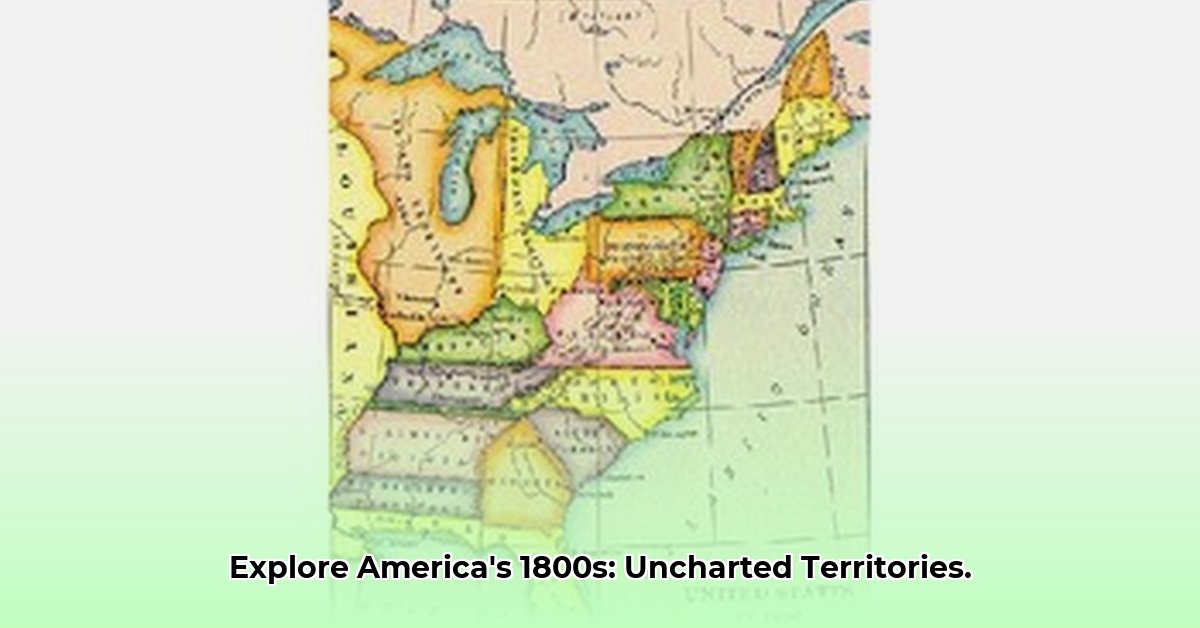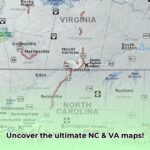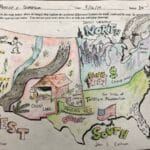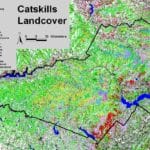Have you ever wondered what the United States looked like on a map in 1800? Envision a nation geographically smaller than today, in the throes of self-discovery, its boundaries a reflection of nascent aspirations. This article explores the history of early American cartography, revealing the evolution of these maps and what they tell us about the nation’s growth, with particular attention to geographical nuances. We’ll examine the creation of these maps, explore their accuracy, or lack thereof, and consider their impact on westward expansion and land ownership—forces that shaped the young United States.
The United States on Display: Territorial Claims and Cartographic Visions
Imagine examining a map of the United States from 1800. Unlike the detailed maps we use today, it portrays a country defined by uncertainty and emerging infrastructure, making it a period of crucial importance for cartographers and historians. This visual record captures the hopes and anxieties of a fledgling republic, marking a pivotal moment in the nation’s early development. Historians recognize early American maps as both geographic documents and political declarations.
Charting the Uncharted: Territories Beyond the Horizon
What would stand out on this map, detailing early settlements and topographic features? The amount of blank space. Extensive western territories remained largely unexplored, often labeled “Uncharted Territory” or described vaguely, reflecting the limited knowledge of the time. The more densely populated eastern seaboard would display established colonies, but even here, boundaries were frequently contested, resulting in a somewhat indistinct picture that provides crucial insights into early legal battles over land ownership. These early maps placed less emphasis on precise measurements and more on asserting claims, mirroring the political maneuvering of the era—a time rife with boundary disputes.
These early maps were more than mere geographic representations of rivers and mountains; they were political manifestos reflecting a struggle for power and influence within the newly formed nation. Each line and label signified a competition for control, influence, and resources. The very act of mapping helped to define the fledgling nation’s identity, solidifying its territories and visually charting its westward expansion. This process dramatically altered the landscape and its inhabitants, establishing a visual claim of territorial control.
From Conjecture to Certainty: The Quest for Accuracy in Geographical Representation
The late 1700s and early 1800s saw significant progress in mapmaking. Improved surveying instruments, more extensive exploration (such as the Lewis and Clark Expedition), and advancements in cartography led to a marked increase in accuracy in the creation of detailed charts. Rivers began to appear more realistic, mountain ranges gained definition, and coastlines were depicted with greater precision, thanks to newly adopted cartographic standards. Yet, even by 1800, vast areas—particularly in the west—remained shrouded in mystery due to the limited geographical knowledge. Some regions were still subject to heated debate among states, with disagreements that occasionally extended to established borders.
The Map as a Political Instrument: Reflecting Ambitions of a Nation
The map of the United States in 1800 was not simply a geographic representation; it served as a potent visual representation of the nation’s political aspirations and ambitions. Still solidifying its place on the global stage, the young country used maps to define “Americanness” by visibly outlining its territories and showcasing its growing influence, particularly in its charting of territorial waters.
Deciphering the Details: Unveiling Stories Behind Boundary Lines
A close examination of these early maps reveals more than just locations and boundaries; it illuminates the distribution of early settlements, the nascent infrastructure of roads and canals (or the lack thereof), and hints at potential conflicts over land and resources, signaled by ambiguous lines or contested regions. When we study these maps, we’re not just looking at geography; we’re gaining insights into the lives of early Americans, their daily struggles and triumphs, and the beginnings of infrastructure projects. It’s history made tangible.
A Tapestry of Time: Legacy of Exploration and National Identity
The maps of the early 1800s offer a powerful connection to our nation’s past, revealing stories of exploration and national identity. More than just historical documents, they are visual narratives of exploration, conflict, expansion, and the ongoing negotiation of identity. Studying these maps provides a unique perspective on the challenges faced by early American cartographers and the political complexities of nation-building, revealing more about the cartographic tools employed than simply the course of rivers or the location of mountains.
Stakeholder Perspectives: Land Speculation and Divergent Interests
Who were the users of these maps, and how did they influence westward expansion? Historians continue to use them to reconstruct the past and understand early territorial claims. Land speculators also used them to identify potentially valuable real estate; government officials used them to chart territories and plan infrastructure; and ordinary citizens used them to plan journeys or simply to understand their ever-expanding nation. Each group interpreted these maps through their own lens, assigning meaning to lines and markings based on individual goals and interests. Understanding these diverse perspectives is crucial for truly grasping the maps’ significance and their impact on various stakeholders.
Digital Exploration: Modern Tools for Historical Cartography
Today, we can access and analyze these historical maps in ways that were unimaginable just a few decades ago, thanks to advancements in geographic information systems (GIS). Digital databases, high-resolution scans of original maps, and advanced GIS tools enable scholars to dissect and analyze this material with incredible precision, offering valuable insights. This collaboration between research institutions and scholars enables rapid advancements in our understanding.
The Enduring Story: Cartographic Analysis Then and Now
The map of the United States in 1800 is more than just a historical artifact; it is a potent tool for understanding the complexities of early American history and its impact on our understanding of territorial expansion. By combining detailed map analysis with other historical documents and information, we enrich our understanding of this pivotal period. These visual representations of the past remind us that the nation’s geography was never static; it was perpetually shaped by human agency, political conflicts, and the relentless pursuit of westward expansion, shedding light on the historical geography.
Surveying the Landscape: How Techniques Shaped Early US Maps (1400-1800)
Imagine trying to draw a map of the United States in 1800 without accurate measurements of its dimensions. That was the challenge faced by early cartographers as they worked to create visual records of a young nation’s expansion. Their maps were only as reliable as the surveying methods used to understand the landscape. How did surveying techniques impact the accuracy of early US maps between 1400 and 1800? The answer is a tale of progress, limitations, and painstaking effort to chart a growing nation.
Early Approaches: Basic Tools, Fundamental Results for Property Demarcation
Early surveying methods involved pacing out distances and using rudimentary tools like ropes and measuring sticks to establish property lines. While lacking modern precision, these techniques yielded surprisingly useful results for basic land allocation and spatial data collection. Farmers and settlers needed to know their property lines, even if the measurements weren’t perfectly accurate. This early surveying directly influenced the accuracy – or inaccuracy – of early maps.
Chains, Compasses, and the Evolution of Land Surveys
The 17th and 18th centuries brought improvements to land surveying. The introduction of the Gunter’s chain – a standardized measuring device – and the magnetic compass brought greater consistency and precision to the process of land surveying. Surveyors could now measure longer distances more accurately, leading to better land surveys and, subsequently, more accurate maps. However, even these advanced tools had limitations. Magnetic compasses are susceptible to variations in Earth’s magnetic field, which affected the accuracy of bearings and could lead to distortions on maps.
Triangulation: Calculating Distances with Precision
Triangulation was a significant advancement in surveying, particularly during a time of vast territorial expansion. By measuring angles and distances between surveyed points, cartographers could create a framework for mapping larger areas with relative accuracy, influencing future geographic data. This technique, combined with improved measuring instruments, drastically improved the precision of maps and provided improved spatial data.
Limitations and Obstacles: Influences on Accuracy and Data
Despite these advancements, limitations persisted in terms of spatial data collection. Vast, unexplored territories presented considerable challenges during this period of territorial expansion. Dense forests, rugged mountains, and the sheer scale of the land created significant obstacles for surveyors. A lack of reliable transportation also hindered surveying efforts, potentially affecting data quality and spatial mapping.
Mapping National Development: Projects, Disputes, and Expansion
The accuracy (or lack thereof) of early maps dramatically impacted various aspects of national development, from infrastructure projects to land disputes, shaping the very fabric of the young nation and greatly influencing landscape mapping. Inaccurate maps led to conflicting claims of land ownership and hampered settlement efforts. They also challenged the ability to properly plan roads, canals, and other infrastructure projects—the lifeblood of expansion during this era of national development.
Progress by 1800: Expansion Reflected
By 1800, significant improvement had been made in measuring territorial expansion. Yet,
- Understand the Dunning-Kruger Effect: Why Incompetent People Think They’re Experts: Gain Self-Awareness - August 1, 2025
- Ignaz Semmelweis: The Doctor Fired for Handwashing: A Public Health Tragedy - August 1, 2025
- Unlock Your Memory: Spaced Repetition: The Scientific Trick to Remembering Information Forever: Learn Effortlessly - August 1, 2025
















